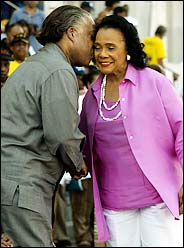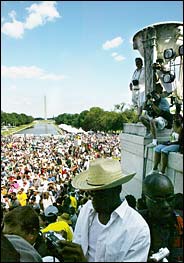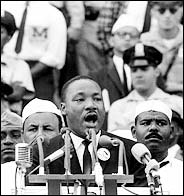


 |
| Stephen Crowley/New York Times |
| The Rev. Al Sharpton with Coretta Scott King. He urged the crowd to "take down the dream busters." |
 |
| Stephen Crowley/New York Times |
| Crowds gathered at the Lincoln Memorial on Saturday. The rally was part of a series of events commemorating the 40th anniversary of the March on Washington. |
 |
| Reuters |
| Since the Rev. Dr. Martin Luther King Jr.'s "I Have a Dream" speech, the focus of the civil rights movement has broadened. |
| The New York Times |
 ASHINGTON, Aug. 23 — The atmosphere was completely new to Raul Yzaguirre, a college student manning a first aid station at the March on Washington on Aug. 28, 1963. Raised in the Rio Grande Valley of Texas, he had been active in the newly emerging Hispanic rights movement, and the gospel songs filling the air, the messages from the black civil rights leaders booming from the speakers' platform, were all unfamiliar.
ASHINGTON, Aug. 23 — The atmosphere was completely new to Raul Yzaguirre, a college student manning a first aid station at the March on Washington on Aug. 28, 1963. Raised in the Rio Grande Valley of Texas, he had been active in the newly emerging Hispanic rights movement, and the gospel songs filling the air, the messages from the black civil rights leaders booming from the speakers' platform, were all unfamiliar.
He was helping to carry a dehydrated woman on a stretcher when the Rev. Dr. Martin Luther King Jr. started to speak. "I stopped and asked her, `Do you mind if I listen?'" said Mr. Yzaguirre, 64, president of the National Council of La Raza, the nation's largest Hispanic advocacy organization. "She said no, she didn't mind, so I just put her down, right there, and began listening."
Forty years after the historic march, Mr. Yzaguirre's journey, from peripheral observer to an influential voice for an ethnic group that recently overtook African-Americans as the country's largest minority, is emblematic of the shifting landscape of the civil rights movement.
As civil rights advocates, old and new, gather this weekend to commemorate what many consider the high point of the struggle for equal rights, they are also taking stock of the movement itself — what it is today, how it got that way, and what it must say, do and become to maintain its relevance. Despite the significance of the anniversary, a rally commemorating the event drew only several thousands. [Page 22.]
The current movement is made up of a sometimes unwieldy collection of groups with issues and interests inconceivable in 1963. They include women, the disabled, Hispanics, Asians and Native Americans. For the first time since civil rights groups began commemorating the anniversary of the march, major conveners of today's march include the Arab American Institute and the National Gay and Lesbian Task Force.
At the same time, the size and influence of the torch-bearing civil rights organizations behind the historic march has diminished, even as their rhetoric and tactics have been adopted by a host of new and disparate causes. The Southern Christian Leadership Conference, now led by Martin Luther King III, son of the slain civil rights leader, is a mere shadow of its former self. The Student Nonviolent Coordinating Committee is gone. Even the N.A.A.C.P nearly went bankrupt in the 1990's.
"It's a whole bevy of people who join what you could still call a movement, but it's something far broader — less spontaneous maybe, but potentially more powerful," said Washington's delegate to Congress, Eleanor Holmes Norton, who helped organize the 1963 march.
More Voices, More Issues
Still, the resulting conglomeration is rife with contradictions and challenges. It is a movement that is more diverse, yet less integrated. It is desirous of new blood, yet often out of touch with younger people. It is embracing new political causes, yet fighting to maintain its political influence. And many of the issues on the current agenda are far more subtle and complex, less easy to package, than the right to register to vote without fear of injury or death.
A recent public service campaign, about housing discrimination by the Leadership Conference on Civil Rights, founded in 1951, highlights the movement's more expansive reach. The radio and television commercials feature a series of prospective renters with strong accents and names like Juan Hernandez, Sanjay Kumar and Tyrone Washington all trying to view an apartment and being turned down on the phone, while the caller who "sounds white" is given an appointment.
"It's necessarily become much more inclusive," Karen Narasaki, executive director of the National Asian Pacific American Legal Consortium, said. "There are many more voices. But there are also more issues."
In 1963 no one considered issues like the racial profiling of Arab-Americans, hate crime legislation for gays and lesbians, or welfare for illegal immigrants.
The broadening of the mandate has not come without tension. "There are some who fear that investing resources in the examination of issues faced by other communities dilutes attention from issues still faced by African-Americans," Ms. Narasaki said.
The movement is also facing a public that is increasingly cool to many of its goals, like affirmative action. In a Gallup poll taken in June, 17 percent of black respondents said they believed that blacks have job opportunities equal to whites. In contrast, 55 percent of whites said they thought blacks and whites had equal chances for employment.
"For many white people, the laws that were passed in the 1960's took care of everything," said Julian Bond, chairman of the N.A.A.C.P. "For them, they just shrug their shoulders and say, `What's the problem? I don't get it.' "
Even the vocabulary of 40 years ago at times falls short of capturing the complexity of the issues championed today. For instance, said Randall Kennedy, a professor at Harvard Law School, a literal interpretation of the word "discrimination" can obscure the disadvantage brought about by historic inequality. The word "racism" does not capture detrimental attitudes or positions that are based on race or are racist.
"We need new lingo," Mr. Kennedy said. "Maybe what groups are fighting against today is subordination. Wielding the old words often lets people off the hook. It doesn't zero in on what is truly culpable in certain conduct."
An Economic Agenda
Some of the seeds of the current struggle for a broadly encompassing but focused message took root around the planning for the 1963 march. Organizers of the 40th-anniversary march promoted it as a march for jobs and freedom.
When they think of the 1963 march, many people today only remember Martin Luther King Jr.'s "I Have a Dream" speech and the calls for racial equality. In fact, access to jobs and eradication of poverty were the initial objectives of the rally. A. Philip Randolph, the influential president of the Brotherhood of Sleeping Car Porters, who called for the march, and Bayard Rustin, who organized it, originally conceived of it as a way to do something about the grinding poverty that afflicted not only blacks, but other groups as well.
"This civil rights demonstration is not confined to the Negro; nor is it confined to civil rights; for our white allies know that they cannot be free while we are not," Randolph said in his speech on the National Mall on the day of the march. "We know that we have no future in which six million black and white people are unemployed, and millions more live in poverty."
But the burning racial strife in the South in the early 1960's focused much of the attention during the march and in the years following on the call to end Jim Crow laws.
In the next five years the primary legal goals of the movement were met with the enactment of the Civil Rights Act of 1964, the Voting Rights Act of 1965 and the Fair Housing Act of 1968. But 40 years later, the liberal economic agenda championed by Randolph, Rustin and King remains stalled in the eyes of many.
In many ways the march and the years directly after were the apex for traditional civil rights groups. Later in the 1960's and 70's, white liberals gravitated toward new moral crusades like opposing the Vietnam War, fighting for women's rights and protecting the environment. Black nationalists eschewed the nonviolent strategies of the old-line civil rights organizations.
The economic stagnation of the 70's and 80's made middle- and working-class whites less supportive of programs to help poor blacks and resentful of efforts like affirmative action that primarily helped middle-class blacks.
"It is one thing to be liberal minded about issues of equality in the 1960's, when the people you're talking about are clearly a subordinate class," said Ron Walters, a political science professor at the University of Maryland. "It is altogether different when the fruits of those efforts usher in a black middle class engaged in social competition for goods."
If the ranks of traditional black civil rights organizations have diminished over the years, it is largely as an outgrowth of their own success. Black intellectuals planned and organized the movements of the 60's. Today they cluster in a slew of black professional organizations, such as those for lawyers, doctors, engineers and journalists, which have sprung up with increasing educational and job possibilities. Others who would lend valuable strategic, financial and marketing skills to the movement are often siphoned off by the much better-paying private sector.
Gaining the right to vote turned the energy of many black people away from the civil rights protests and towards the political arena. In 1970, seven years after the March on Washington, there were 1,469 black elected officials in the United States, according to the Joint Center for Political and Economic Studies, which studies black-oriented issues. By the year 2000, the number had reached more than 9,000. Some say there are still mass demonstrations of black people seeking to secure rights and advantages. They are now called elections.
"And those are the best kinds of demonstrations to have," Ms. Norton said.
'We Just Acted'
Some veteran civil rights advocates bemoan the lack of involvement in older organizations and causes as apathy born of privilege. "In 1963 we didn't have Web sites, cellular phones or fax machines," said Representative John Lewis of Georgia, 63, who as chairman of the Student Nonviolent Coordinating Committee was the youngest speaker at the march 40 years ago. "We just acted."
Many who came of age after the pivotal years of the movement argue that a change of focus and tactics is only natural. "Success today in motivating people is not necessarily defined by getting 100,000 people out to a march," said Nelson George, 45, an author, film producer and pop culture critic. "For some people it may be about 100,000 hits on a Web site. And that's O.K."
For all the talk of new rhetoric and new strategies, some scholars of the movement say its future lies with people who know little of its origins.
Rogers M. Smith, a professor of political science at the University of Pennsylvania and the author of "The Unsteady March: The Rise and Decline of Racial Inequality," said the movement's future would depend largely on how closely new immigrants identify with the goals of the civil rights struggle and how readily the movement embraces them.
"All we need to do, really, is agree to a set of principles and stick to them," Mr. Yzaguirre said. "If a program is for the poor, then it should focus on all poor people. If we're going to have a diversity program, then it should be truly diverse. We can't accept a system anymore where any member is a junior partner."